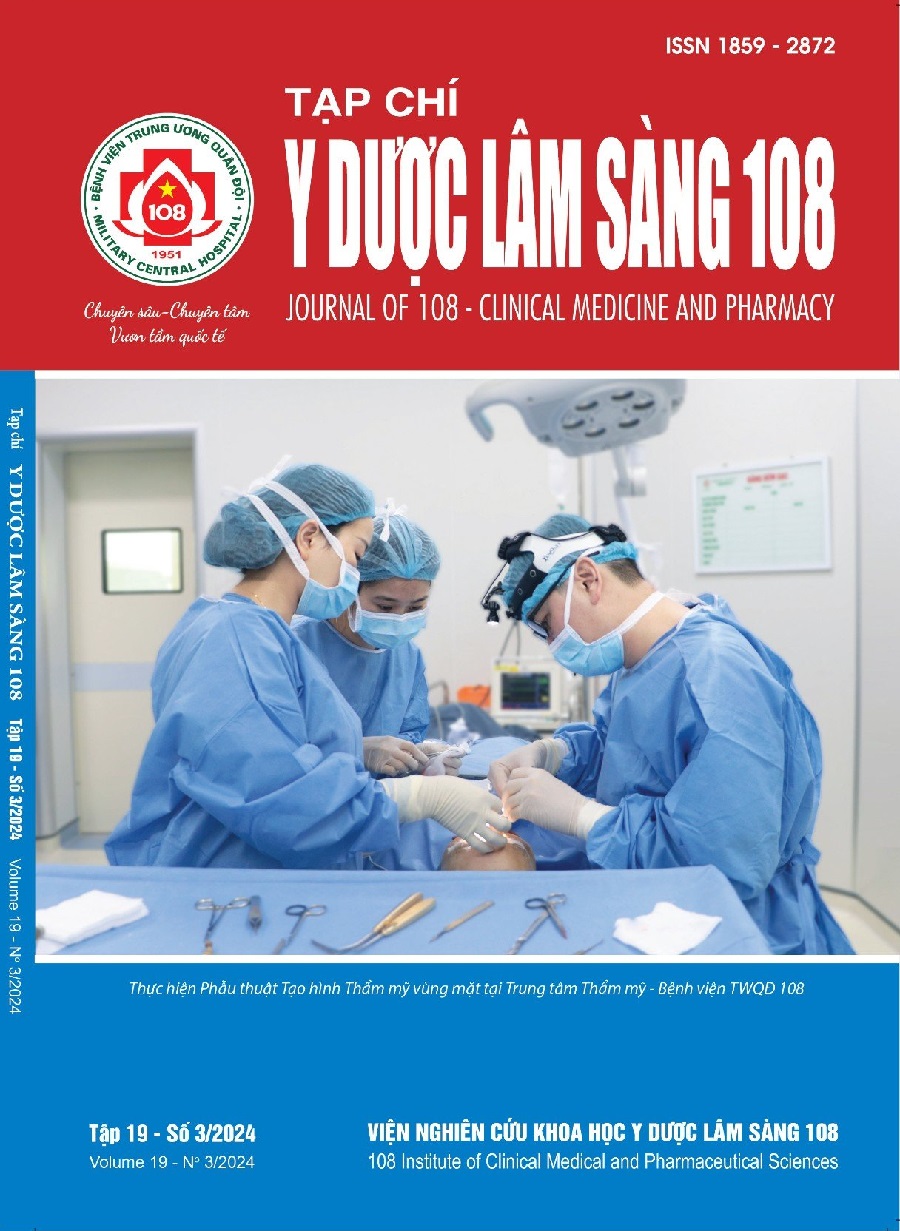Evaluation of the relationship between S.T.O.N.E score on MSCT and the effectiveness of percutaneous nephrolithotomy
Main Article Content
Keywords
Abstract
Objective: The aim of this study was to evaluate the relationship between S.T.O.N.E score on multi-slice computed tomography (MSCT) and the effectiveness of percutaneous nephrolithotomy (PCNL). Subject and method: A descriptive study on 71 patients with kidney stones, who underwent multi-slice CT scan of the urinary system before PCNL at Hanoi Medical University Hospital from July 2022 to July 2023 and agreed to participate in the study. The S.T.O.N.E score included five factors: Stone Size (or stone area), Tract length, Obstruction, Number of involved calices and Essence of stone density was used to evaluate the complexity of kidney stones and to compare it with the effectiveness of PCNL. Result: The mean age of the patient group was 53.8 ± 12.3. Male/female ratio was 1.54. The S.T.O.N.E scores were 6 (n = 17), 7 (n = 16), 8 (n = 13), 9 (n = 8), 10 (n = 9), 11 (n = 5) and 12 (n = 3) had a close correlation with lithotripsy time (r = 0.94, p=0.001) and stone clearance rate (r = -0.97, p<0.001). Conclusion: Assessing the complexity of kidney stones using the S.T.O.N.E scale was meaningful in predicting the effectiveness of percutaneous nephrolithotomy so it would needs to be applied conventionally before PCNL.
Article Details
References
2. Okhunov Z, Friedlander JI, George AK, Duty BD, Moreira DM, Srinivasan AK et al (2013) S.T.O.N.E. nephrolithometry: Novel surgical classification system for kidney calculi. Urology 81: 1154‐1159.
3. de la Rosette J, Assimos D, Desai M, Gutierrez J, Lingeman J, Scarpa R, Tefekli A; CROES PCNL Study Group (2011) The Clinical Research Office of the Endourological Society Percutaneous Nephrolithotomy Global Study: Indications, complications, and outcomes in 5803 patients. J Endourol 25: 11‐17.
4. Liu Y, Chen Y, Liao B, Luo D, Wang K, Li H, Zeng G (2018) Epidemiology of urolithiasis in Asia. Asian J Urol 5(4): 205-214.
5. Thomas K, Smith NC et al (2011) The Guy’s stone score - Grading the complexity of percutaneous nephrolithotomy procedures. Urology 78: 277‐281.
5. Smith A, Averch TD, Shahrour K, Opondo D, Daels FP, Labate G et al (2013) A nephrolithometric nomogram to predict treatment success of percutaneous nephrolithotomy. J Urol 190: 149‐156.
6. Kumar U, Tomar V, Yadav SS, Priyadarshi S, Vyas N, Agarwal N, Dayal R (2018) STONE score versus Guy’s Stone Score ‐ predictors for success rate and complications in PCNL. Urol Ann 10(1):76-81.
7. Akhavein A, Henriksen C, Syed J, Bird VG (2015) Prediction of single procedure success rate using S.T.O.N.E. nephrolithometry surgical classification system with strict criteria for surgical outcome. Urology 85: 69‐73.
8. Farhan M, Nazim SM, Salam B, Ather MH (2015) Prospective evaluation of outcome of percutaneous nephrolithotomy using the ‘STONE’ nephrolithometry score: A single‐centre experience. Arab J Urol 13: 264‐269.
9. Labadie K, Okhunov Z, Akhavein A, Moreira DM, Moreno-Palacios J, Del Junco M, Okeke Z, Bird V, Smith AD, Landman J (2015) Evaluation and comparison of urolithiasis scoring systems used in percutaneous kidney stone surgery. J Urol 193: 154‐159.
 ISSN: 1859 - 2872
ISSN: 1859 - 2872
